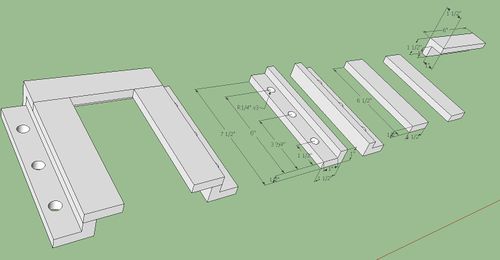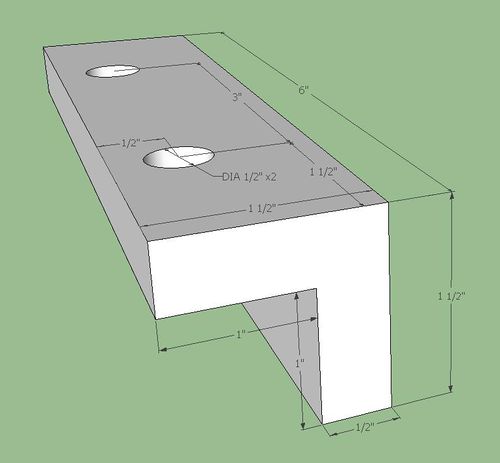Brian Peters Log
Sat Sept 14, 2013
Pivot redesign
Sat July 6, 2013
Here is an alternative to the Tooth Assembly. I removed the bottom attachment part. The total height is 1 inch the total length of the teeth is 4 inches. The teeth are meant to be welded on to the attachment plate. Easy. Simple. Durable. Replaceable. Convenient. What's not to like?
Fri July 5, 2013
Great work. Tooth bar review: See http://blog.opensourceecology.org/2008/10/breakthroughs-teeth-and-other/ for tooth design rationale. We have now used 1" rebar instead of 1x1 bar stock. Don't need the double attachment - single layer of bolton allows full clamping, whereas yours just bolts into place. Flat bolt-on is easier and is a tighter fit. I am interested in prototyping your bucket via 3D print if you can generate the printing files for the 3D printing file generation step of OSE_Design_Sprint#Design_Process. See LifeTrac Development Matrix for the green rows to see general proccess of 3D printing file generation.
Here is the Tooth Assembly. It is designed to fit into the Bucket and bolted thereto.
Tooth Assembly
The Quick Attachment Insertion Plate is centered along the longitudinal axis with the Stick Mounting Plate. Joining can be performed by bolting with recessed holes so that the surfaces remain flush/flat. Welding may be attempted but the residual bead left behind at the welded joints may cause interference and hinder/prevent the assembly from being inserted into the Quick Attachment Envelope on the Bucket. I am a little concerned about the 90 degree turns on the Quick Attachment Insertion Plate. These would be stress concentration points and, unless filleted or chamfered, will result in fatigue cracks. If fatigue cracks were to result the Bucket would suddenly and unexpectedly become detached from the Stick. This would be dangerous. Thus fillets or chamfers are recommended. A possible alternative construction would be to separate the Quick Attachment Insertion Plate into two separate plates, one being 1/2 inch thick the other 1 inch thick; joined together by an adhesive/epoxy and bolt combination. The adhesive/epoxy would be insurance due to the significant amount of stress this component will see. The exterior edge of the Quick Attachment Insertion Plate that is to be initially inserted into the Quick Attachment Envelope on the Bucket may be rounded or tapered to facilitate alignment and insertion of the plate into the envelope.
Stick Mounting Plate
Quick Attachment Insertion Plate
Quick Attachment Insertion Plate Joined with Stick Mounting Plate
Stick's Distal Pivoting Plate
Thurs July 4, 2013
I added dimensions to all of the components. The individual components of the Quick Attachment were intended to be welded together unless they were meant to be bolted together as indicated by bolt holes. Tolerances were NOT built into the model or dimensions.
Bucket hole placement
Quick Attachment Assembly
Quick Attachment Securing Bracket
Joining of Bucket and Quick Attachment Assembly
Fri Jun 28, 2013
My latest working file: File:Warehouse13.skp
Backhoe:
The design constraints of the Backhoe was that it must be able to dig a hole 6 feet cubed. The furthest corner of the hole that the Backhoe must reach is 6*sqrt(2)= 8'6". As can be seen from the screenshots below the reach extension of the Backhoe's Boom, Stick, and Bucket is 9'10". Leaving an extra 1'4" for height of the backhoe off the ground. The reach depth is taken from a horizontal boom and is 6'5". If the boom is declined then the reach depth that the Bucket can extend to will be extended. Thus two out of the three dimensions exceed the design requirements of 6 feet. The reach of the Boom alone is 4'8.5". Thus with a reach that long the degree of rotation necessary to swing the Stick 3 feet off center to achieve a 6 foot range of motion is about 37 degrees.
Quick Attachment Assembly:
The Quick Attachment was designed to be easily fabricated by welding angle iron together. I included a few bolt holes which will facilitate assembly of the Quick Attachment to the Bucket. By making the Quick Attachment detachable it is now possible to fabricate only one Quick Attachment part and employ it on other tools to be attached (auger, jackhammer, etc.), if so desired. Permanent attachment of the Quick Attachment is also possible.
Sat Jun 15, 2013
Here is my latest file File:Warehouse12.skp
Fri, June 14, 2013
The Boom has been simplified by removing the 30 degree bend. This was done in order to have the simplest manufacturing process possible for the first version of the Backhoe. In later versions the 30 degree bend might be reinstated.
Bucket:
There have been several designs for the Bucket. The Bucket was first designed with a curve back, as is common on most buckets. Keeping in mind the goal of the simplest manufacturing process possible and after consulting with Marcin, a flat panel design was preferred over the curve design since curving a 1/2" thick steel plate would be difficult. Thus the curved back was abandoned and has been redesigned to be constructed out of 8" x 16" stock plates 1/2" thick, welded together. Further work is required, namely the Tooth Assembly and the Quick Attachment.
The orientation of the Bucket is contemplated to be primarily as shown below; with the scooping action to be towards the user. However, it may be desirable to have the orientation of the Bucket reversed 180 degrees; with the scooping action to be away from the user. This is shown here [1].
Quick Attachment: I have come up with a design that is the simplest I can think of in terms of manufacturing and provides proper constraint in all degrees of freedom. It is an envelope system. A plate will be attached to the articulated attachment plate at the end of Stick. The item to be attached (i.e. the bucket, auger drill, jackhammer, etc.) will have an envelope attached at the attachment end. The articulated attachment plate at the end of the Stick will slide into the envelope in order to secure the item. An "L" shaped piece of angle iron may then be secured to prevent the item to be secured from sliding out/off of the articulated attachment plate. Securing my be attained by a pin and cotter pin combo or by nut and bolt. Once the item needs to be removed a simple removal of the pin and cotter pin or nut and bolt will release the item.
There are other means of quick attachment, but those means are either secured by intellectual property rights or involve complex manufacturing with specialized parts that would be difficult to produce from our stock supply of parts. For those reasons I have employed the envelope system.
Stick Hinge I have also started work on the hinge between the Stick and the item to be attached. I am trying to ensure full movement of the Bucket.
The preferred bucket would be the one third from the left (second closest) due to a desirable balance between volumetric capacity and the sharpest digging angle of the four choices.
Mon, May 27, 2013
Starting with User:Samthetechie's file File:Warehouse.skp I designed the Boom of the Backhoe.
The Joint: At the bend in the Boom is a 30 degree Joint. A bend will balance the depth and reach of the bucket. The degree of the bend need not be at 30 degrees. 30 degrees was selected merely for ease of calculations and based on the trig of a 30/60/90 triangle. The half inch thick Joint comprises two 8 inch wide plates welded together. On the concave side of the joint is a half inch diameter hole that will eliminate any stress concentration at that point. This is necessary to prevent stress fracture and sudden premature failure of the joint which could cause severe injury. The mounting holes in the joint are standard 1 inch diameter. If the joint needs to be made stronger more may be added.
The Wedge: On the interior of the Joint is an optional quarter inch thick Wedge. The wedge may fill in the gap between the 4 inch tubing. If used the Wedge should be welded to the tubing. Its purpose is to strengthen the Joint by making both sections of tubing one piece. I also included a plate for attaching the hydraulic cylinder which will control the vertical movements of the Boom and Stick. The location of this plate is not fixed, however, it is currently located on the Joint in order to minimize the stress on the joint.
The Stick: The present configuration of the Stick has a pivot plate arranged to act as a fulcrum. This arrangement allows the Stick to have maximum range of motion. Further, the increased length of the Stick extending above the Boom increases the lever arm of the hydraulic cylinder which reduces the force needed to be exerted thereby. This will increase the durability and lifespan of that cylinder.
Next item to be worked on will be the Bucket and its attachment to the Stick. The sketchup file of the Stick and the Boom can be found at File:Warehouse11.skp while a picture can be seen below.
Sat, May 25, 2013
Hey Brian, thanks for collaborating with User:Marcin and User:Samthetechie on the Backhoe today, can you write a few notes on your findings / approach for today. Also, you might find these new parts I uploaded helpful / interesting: File:Boom.skp and File:Stick.skp
Fri, May 17, 2013
Talked to Marcin about Backhoe Stick and Boom Concept Specification. Started work on the backhoe stick and boom. Made stock parts and did an assembly of the boom.
Links to Nickle Iron Battery (NiFe Battery)
Edison Patents
http://www.google.com/patents/US678722 http://www.google.com/patents/US692507
Helpful Youtube Videos
The author of the video "edsworkshop" has several videos from 1.0-1.15 on how to make a nickle iron battery. Below is the link to the first video.

















